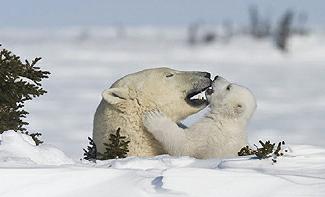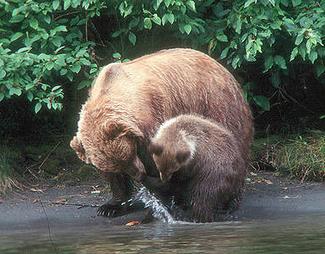Grizzly Bears Move In On Canadian Polar Bear Habitat
NEW YORK, New York, February 25, 2010 (ENS) - Grizzly bears are roaming into what has been traditionally thought of as polar bear habitat in the Canadian province of Manitoba, where they are officially listed as extirpated, new research has found.
Biologists affiliated with the American Museum of Natural History, City College of the City University of New York have observed grizzly bears, Ursus arctos horribilis, in Canada's Wapusk National Park.
Located along the shores of the Hudson Bay, in the northern tip of Manitoba, the park protects one of the world's largest known polar bear maternity denning areas. The grizzlies were seen either along rivers known to harbor fish or in an area known for berries.
"Grizzly bears are a new guy on the scene, competition and a potential predator for the polar bears that live in this area," says Robert Rockwell, a research associate at the Museum and a professor of biology at CUNY.
 |
Polar bear mother and cub in Wapusk National Park (Photo courtesy Parks Canada) |
The preliminary data was published in the journal "Canadian Field Naturalist" and shows that sightings of grizzlies in the park are recent and appear to be increasing in frequency.
"The first time we saw a grizzly we were flying over the middle of Wapusk, counting fox dens, when all of the sudden Linda Gormezano, a graduate student working with Rockwell and a co-author of the paper, shouted 'Over there, over there - a grizzly bear.' And it wasn't a dirty polar bear or a moose," said Rockwell. "We saw the hump."
That sighting in August 2008 spurred Rockwell and Gormezano to look through records to get a better picture of the bear population in the park.
They found no evidence of grizzly bears before 1996, not even in the trapping data from centuries of Hudson Bay Company operations in the area.
But between 1996 and 2008 the team found nine confirmed sightings of grizzly bears, and in the summer of 2009 there were three additional observations.
"The opportunistic sightings seem to be increasing," says Gormezano. "This is worrying for the polar bears because grizzly bears would likely hibernate in polar bear maternity denning habitat. They would come out of hibernation at the same time and can kill polar cubs."
Before this study, researchers thought that the barren landscape north of the Hudson Bay was an impassable gap in resources for potentially migrating grizzly bears.
But some grizzly bears have managed to move from their historic ranges in the British Columbia, the Rockies, the Yukon, and Nunavut, probably because of their flexible, mixed diet of berries and meat, the scientists say.
 |
Grizzly mother teaches her cub to fish in a Yukon river. (Photo by Gordon MacRae) |
They observe that the gap was navigable, and now some grizzly bears have reached the abundant caribou, moose, fish, and berries found in Canada's Wapusk National Park.
"Although we don't yet know if they are wandering or staying - the proof will come from an observed den or cubs - these animals will eventually be residents of this national park," says Rockwell. "The Cree elders we talked to feel that now that grizzly bears have found this food source they will be staying."
Wapusk means "White Bear" in Cree. The park was so named because it encompasses one of the world's largest polar bear maternity denning areas. It represents the Hudson James Lowlands natural region bordering on Hudson Bay. The park lies on the transition between boreal forest and Arctic tundra.
"A big question is how to deal with these new residents," says Gormezano. "In Canada, both the polar and grizzly bear are federally listed as species of special concern. In Manitoba, the polar bear is provincially listed as threatened while the prairie population of the grizzly bear is listed as extirpated."
The grizzly bear was placed on Manitoba's extirpated species list in 1996. Extirpated species are plants and animals that have disappeared from Manitoba but exist in other parts of Canada or the world.
Extirpated species are candidates for possible recovery in Manitoba, although the government notice of extirpation says that "in many instances, like the grizzly bear ... this may not be possible due to changes in urbanization."
In addition to Rockwell and Gormezano, this paper was authored by Daryll Hedman of Manitoba Conservation, a provincial government agency. This research was supported in part by the Hudson Bay Project.
Copyright Environment News Service (ENS) 2010. All rights reserved.
To subscribe or visit go to: http://www.ens-newswire.com